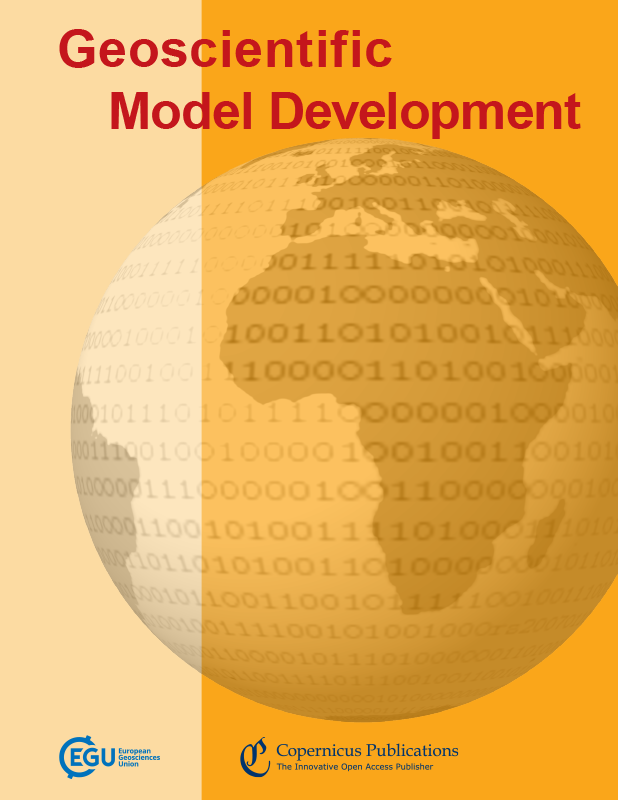所有乘坐!基于ch220 - choo TRAIN v1.0的地球系统研究
IF 4.9
3区 地球科学
Q1 GEOSCIENCES, MULTIDISCIPLINARY
引用次数: 0
摘要
摘要在过去的50年里,地质(104年)时间尺度上的碳循环和气候模型有了巨大的改进,这是由于我们对地球系统的理解的进步和模拟地球系统关键过程的计算能力的提高。然而,平衡地球系统的复杂性和模型的计算费用是模型开发中的主要挑战。跨越数十万年或更长时间的模拟通常需要降低气候系统的复杂性,忽略辐射反馈、大气环流的变化以及冰盖的膨胀和衰减等特征,这些特征可能对长期碳循环产生深远影响。在这里,我们提出了一个气候和长期碳循环的模型,该模型捕捉了全球气候的许多基本特征,同时保留了模拟数百万年时间所需的计算效率。碳-水耦合陆地径流和日照水文模型(cho2 - choo TRAIN)将一维(纬向)湿润静态能量平衡气候模型与岩石风化和长期碳循环模型耦合在一起。cho2 - choo TRAIN能够在笔记本电脑上运行大约30分钟的百万年模拟。该框架的主要优点是:(1)它模拟了基本的气候强迫和反馈;(二)考虑地理配置;(3)它是灵活的,可以很容易地添加特征,改变反馈的强度,并规定条件,这些条件通常是硬编码的,或者是更复杂模式的紧急属性,如气候敏感性和经向热输送的强度。我们展示了控制温度和水循环的气候变量如何影响长期的碳循环和气候,我们讨论了这种影响的大小和方向如何取决于大陆地理等边界条件。本文概述了模型方程,给出了气候响应对不同气候和碳循环扰动的敏感性分析,并讨论了cho2 - choo列车的潜在应用和下一站。本文章由计算机程序翻译,如有差异,请以英文原文为准。
All aboard! Earth system investigations with the CH2O-CHOO TRAIN v1.0
Abstract. Models of the carbon cycle and climate on geologic (>104-year) timescales have improved tremendously in the last 50 years due to parallel advances in our understanding of the Earth system and the increase in computing power to simulate its key processes. Still, balancing the Earth system's complexity with a model's computational expense is a primary challenge in model development. Simulations spanning hundreds of thousands of years or more generally require a reduction in the complexity of the climate system, omitting features such as radiative feedbacks, shifts in atmospheric circulation, and the expansion and decay of ice sheets, which can have profound effects on the long-term carbon cycle. Here, we present a model for climate and the long-term carbon cycle that captures many fundamental features of global climate while retaining the computational efficiency needed to simulate millions of years of time. The Carbon–H2O Coupled HydrOlOgical model with Terrestrial Runoff And INsolation, or CH2O-CHOO TRAIN, couples a one-dimensional (latitudinal) moist static energy balance model of climate with a model for rock weathering and the long-term carbon cycle. The CH2O-CHOO TRAIN is capable of running million-year-long simulations in about 30 min on a laptop PC. The key advantages of this framework are (1) it simulates fundamental climate forcings and feedbacks; (2) it accounts for geographic configuration; and (3) it is flexible, equipped to easily add features, change the strength of feedbacks, and prescribe conditions that are often hard-coded or emergent properties of more complex models, such as climate sensitivity and the strength of meridional heat transport. We show how climate variables governing temperature and the water cycle can impact long-term carbon cycling and climate, and we discuss how the magnitude and direction of this impact can depend on boundary conditions like continental geography. This paper outlines the model equations, presents a sensitivity analysis of the climate responses to varied climatic and carbon cycle perturbations, and discusses potential applications and next stops for the CH2O-CHOO TRAIN.
求助全文
通过发布文献求助,成功后即可免费获取论文全文。
去求助
来源期刊

Geoscientific Model Development
GEOSCIENCES, MULTIDISCIPLINARY-
CiteScore
8.60
自引率
9.80%
发文量
352
审稿时长
6-12 weeks
期刊介绍:
Geoscientific Model Development (GMD) is an international scientific journal dedicated to the publication and public discussion of the description, development, and evaluation of numerical models of the Earth system and its components. The following manuscript types can be considered for peer-reviewed publication:
* geoscientific model descriptions, from statistical models to box models to GCMs;
* development and technical papers, describing developments such as new parameterizations or technical aspects of running models such as the reproducibility of results;
* new methods for assessment of models, including work on developing new metrics for assessing model performance and novel ways of comparing model results with observational data;
* papers describing new standard experiments for assessing model performance or novel ways of comparing model results with observational data;
* model experiment descriptions, including experimental details and project protocols;
* full evaluations of previously published models.
 求助内容:
求助内容: 应助结果提醒方式:
应助结果提醒方式:


